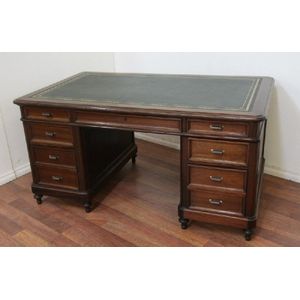French Louis XVI Walnut Commode with Marble Top
You must be a subscriber, and be logged in to view price and dealer details.
Subscribe Now to view actual auction price for this item
When you subscribe, you have the option of setting the currency in which to display prices to $Au, $US, $NZ or Stg.
- Pilasters - In furniture a pilaster is a flattened column-like detail
applied to furniture. It is similar to a pilaster in architecture, but it is
typically smaller and less ornate. Pilasters are often used to decorate the
fronts of bookcases, cabinets, and other pieces of furniture. Pilasters can be
made of wood, metal, or other materials. They can be fluted, carved, or plain.
Pilasters are often used to add a touch of elegance and sophistication to
furniture. - Turning - Any part of a piece of furniture that has been turned and shaped with chisels on a lathe. Turned sections include legs, columns, feet, finials, pedestals, stretchers, spindles etc. There have been many varieties and fashions over the centuries: baluster, melon, barley-sugar, bobbin, cotton-reel, rope-twist, and so on. Split turning implies a turned section that has been cut in half lengthwise and applied to a cabinet front as a false decorative support.
- Stringing - Fine inlaid lines, in contrasting colour to the carcase timber, found mainly on furniture made in the styles of the later 18th and early 19th centuries. Stringing, which may be of satinwood, pine, ebony, horn, brass or occasionally ivory, is found principally on drawer fronts, around the outer edges of usually tapered legs and French bracket feet, around the edges of inlaid panels and between the joint of the cross banding and carcase timber on table tops, chests of drawers, cabinets etc. The effect is to emphasize the line of the piece and add to the impression of lightness and elegance. Stringing also occurs in Sheraton-revival-style furniture of the later 19th and early 20th centuries.
- Commode - The word "commode" when used to describe an item of furniture, has three usuages:
1. As used to describe an item of English furniture, it refers to what is euphemistically called a 'night table', that is a small cabinet concealing a chamber pot.
2. In its 18th century French usuage it describes a low and highly decorated chest of drawers for salons and reception rooms. A bombe commode is a commode with rounded sides and front, giving the chest a somewhat swollen look.
3. It is also used to denote a half round or serpentine shaped cabinet, with panelled doors, standing on legs. They were pieces on which the cabinetmaker lavished his most accomplished art, with rich veneers, marquetry inlays, gilt mounts and other ornamentation. - Frieze - An architectural term denoting the flat, shaped or convex horizontal surface of furniture, between the architrave and the cornice, usually found on a cabinet or bookcase, or on desks and tables where it may include drawers, the area between the top and the legs. In ceramics, the term refers to the banding, of usually a repeating pattern, on the rims of plates and vases.
This item has been included into following indexes:
Visually similar items

A French Louis XV style walnut commode breakfront with marble top, above drawers with marquetry decoration flanked by ormolu corbels on tapering legs with ormolu sabots. 84 cm high, 116 cm wide, 49 cm deep

A French Louis XV style walnut bureau, the rectangular hinged fall front enclosing a fitted interior with drawers and pigeon holes, below three drawers with ormolu handles and escutcheons, with a shaped apron on tapering legs with ormolu sabots. 95 cm high

A Chippendale revival flame mahogany desk, the top with inset gold tooled leather, above frieze drawers, on two pedestals, each with carved canted corners on bracket feet. 75 cm high, 137 cm wide, 75 cm deep.

A French mahogany tooled leather top twin pedestal desk. 75 cm high, 150 cm wide, 90 cm deep.
